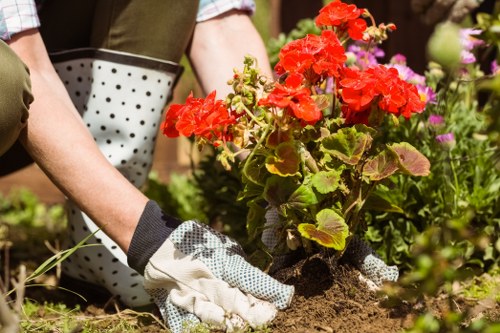Grass Cutting Temple: A Sanctuary of Tradition and Nature

The Grass Cutting Temple stands as a remarkable blend of tradition and natural beauty. Nestled in the heart of the countryside, this temple not only serves as a place of worship but also as a testament to sustainable practices and community spirit.
For centuries, the temple has been meticulously maintained, with its lush green surroundings symbolizing growth and renewal. The act of grass cutting here goes beyond mere maintenance; it is a ritual that reinforces the connection between the devotees and nature.
Visitors to the Grass Cutting Temple are often mesmerized by the harmonious environment, where every blade of grass is cared for with devotion. This dedication reflects the temple's core values of respect for nature and the importance of preserving it for future generations.
History of Grass Cutting Temple
Origins and Founding
The Grass Cutting Temple was established in the early 18th century by a group of devoted followers who sought a serene place to practice their faith away from the chaos of urban life. The founders believed that maintaining the temple grounds was a sacred duty, embodying the principles of purity and discipline.
Evolution Through the Years
Over the decades, the temple has evolved both in structure and in the practices it upholds. While the core mission of providing a peaceful sanctuary remains unchanged, the methods of grass cutting have adapted to incorporate eco-friendly techniques, reflecting a growing awareness of environmental conservation.

This evolution signifies the temple’s commitment to staying relevant and responsive to the needs of both its immediate community and the broader ecological landscape.
The integration of modern tools and sustainable practices has not only made grass cutting more efficient but has also minimized the environmental impact, ensuring that the temple grounds remain a vibrant and living testament to the harmony between tradition and progress.
As the temple continues to grow, it remains a beacon of hope and continuity, preserving ancient customs while embracing the future.
Architectural Significance
Design Elements
The architecture of the Grass Cutting Temple is a unique blend of traditional and contemporary styles. The main structure features intricate carvings and spacious courtyards, designed to facilitate ease of movement and communal activities.
Symbolism and Meaning
Every architectural element within the temple holds symbolic significance. The grass-covered areas represent abundance and life, while the pathways are designed to guide visitors on a spiritual journey, fostering a sense of peace and introspection.

The use of natural materials in construction not only enhances the aesthetic appeal but also underscores the temple’s commitment to sustainability. This harmonious integration with nature creates an environment that is both spiritually uplifting and environmentally responsible.
The design also incorporates spaces for meditation and reflection, ensuring that visitors can engage deeply with their spiritual practices in a tranquil setting.
Overall, the architectural brilliance of the Grass Cutting Temple plays a pivotal role in its function as a sanctuary, blending beauty with purpose.
Grass Cutting Rituals and Practices
Daily Maintenance
Grass cutting at the temple is not just a routine task but a sacred ritual performed daily by the temple staff and volunteers. This practice symbolizes the maintenance of spiritual and physical well-being, reflecting the cyclical nature of life.
Special Ceremonies
Throughout the year, the temple hosts several ceremonies focused on grass cutting, each with its own unique significance. These events are often accompanied by prayers and offerings, reinforcing the connection between the community and the natural world.

These special ceremonies attract devotees and visitors alike, fostering a sense of unity and shared purpose. The collective effort involved in these rituals highlights the importance of community participation in sustaining the temple’s environment.
Moreover, these ceremonies serve as educational opportunities, teaching younger generations the value of environmental stewardship and the importance of maintaining sacred spaces.
By intertwining spirituality with practical maintenance, the temple creates a holistic approach to worship and community life.
Community and Cultural Impact
Role in Local Community
The Grass Cutting Temple plays a vital role in the local community, serving as a center for cultural activities, social gatherings, and spiritual growth. It provides a space where individuals can come together to celebrate festivals, engage in communal work, and support one another.
Cultural Festivals
Various cultural festivals are celebrated at the temple, each highlighting different aspects of local traditions and practices. These events not only preserve cultural heritage but also promote inclusivity and diversity within the community.

The temple’s involvement in community development extends beyond religious activities. It actively participates in environmental conservation projects, educational programs, and social welfare initiatives, making it a cornerstone of the community.
Through its multifaceted role, the Grass Cutting Temple fosters a strong sense of identity and belonging among its members, contributing to the overall well-being and resilience of the community.
Its cultural and social impact is a testament to the temple’s enduring legacy and its ability to adapt to the evolving needs of society.
Visiting Grass Cutting Temple
What to Expect
Visitors to the Grass Cutting Temple can expect a serene and welcoming atmosphere. The temple grounds are meticulously maintained, offering a peaceful retreat from the hustle and bustle of everyday life.
Best Times to Visit
The best times to visit the temple are during early morning or late afternoon when the weather is pleasant, and the surroundings are at their most picturesque. These times also coincide with various rituals and ceremonies, providing a deeper insight into the temple’s spiritual practices.

Guided tours are available for those interested in learning more about the temple’s history, architecture, and daily maintenance routines. These tours are led by knowledgeable guides who are passionate about sharing the temple’s story and significance.
Visitors are encouraged to participate respectfully in the temple’s activities, observing the rituals and practices with mindfulness and reverence.
Whether you are seeking spiritual solace or simply wish to appreciate the beauty of the temple, a visit to the Grass Cutting Temple is sure to be a fulfilling experience.
Nearby Areas
The Grass Cutting Temple is surrounded by several noteworthy areas, each contributing to the overall charm and accessibility of the temple. Here are some of the closest areas:
- Greenfield Park: Located just 2 kilometers from the temple, Greenfield Park offers expansive picnic areas and walking trails, perfect for a leisurely afternoon.
- Riverbend Village: Situated 3 kilometers away, Riverbend Village is known for its scenic river views and vibrant local markets.
- Sunrise Hill: Only 4 kilometers from the temple, Sunrise Hill provides stunning vistas and is a popular spot for sunrise watchers.
- Harmony Gardens: 5 kilometers distant, Harmony Gardens is a botanical garden that complements the temple’s green ethos.
- Misty Woods: At a distance of 6 kilometers, Misty Woods offers tranquil walking paths and diverse flora, ideal for nature enthusiasts.
- Lakeside Retreat: Located 7 kilometers away, Lakeside Retreat features a beautiful lake and recreational facilities for visitors.
- Quiet Meadows: 8 kilometers from the temple, Quiet Meadows is known for its peaceful ambiance and open grassy fields.
- Forest Grove: Situated 9 kilometers away, Forest Grove boasts dense woodlands and is a favorite among hikers.
- Crystal Springs: At 10 kilometers distance, Crystal Springs is home to natural springs and offers refreshing spots for relaxation.
- Bluebird Hill: 11 kilometers from the temple, Bluebird Hill is renowned for its bird-watching opportunities and scenic landscapes.
Frequently Asked Questions
1. What is the significance of grass cutting at the temple?
Grass cutting at the Grass Cutting Temple is a sacred ritual that symbolizes the maintenance of spiritual purity and the harmony between humans and nature. It reinforces the community's commitment to environmental stewardship.
2. Can visitors participate in the grass cutting rituals?
Yes, visitors are welcome to participate in grass cutting rituals. This involvement provides a deeper understanding of the temple's practices and fosters a sense of community participation.
3. What are the best times to visit the temple?
The best times to visit the temple are early mornings and late afternoons when the weather is pleasant, and various rituals and ceremonies are taking place.
4. Are there guided tours available at the Grass Cutting Temple?
Yes, guided tours are available for visitors interested in learning more about the temple’s history, architecture, and daily practices. These tours are led by knowledgeable guides.
5. What nearby attractions can visitors explore after visiting the temple?
After visiting the temple, visitors can explore nearby attractions such as Greenfield Park, Riverbend Village, Sunrise Hill, and Harmony Gardens, among others, which offer a variety of recreational and scenic experiences.

